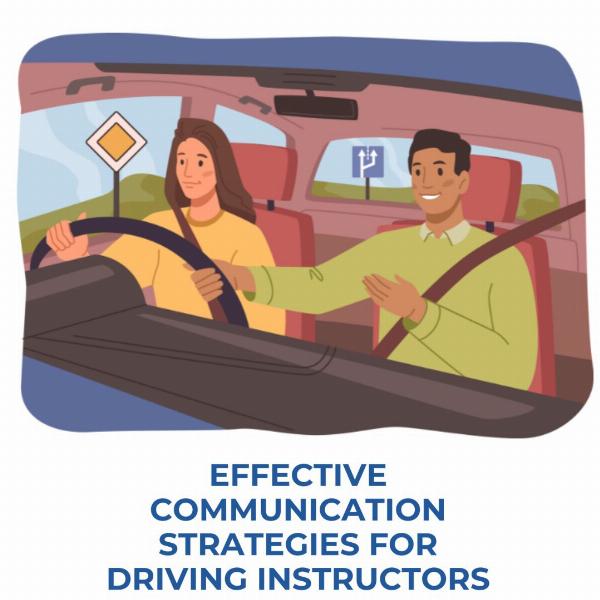If you're not 100% sure how to write a blog post that clicks with readers, don't sweat it.
The reality? Blogging is a major struggle for most businesses out there.
And hey, we totally understand why.
From coming up with ideas to actually putting pen to paper digitally, a worthwhile blog post requires some serious effort.
That said, the benefits of blogging for business are worth racking your brain for. The correlation between businesses that blog scoring more traffic, conversions and leads is well-documented.
The takeaway? Learning how to write a blog post is an invaluable skill no matter what you're selling.
That's why we put together this guide breaking down the anatomy of a good blog post and how to write one yourself.
What makes a good blog post, anyway?
Before we get knee-deep into how to write a blog post, let's talk about what the best blog posts have in common.
Although blogging is certainly a skill, you don't need to be Shakespeare to start writing 'em.
Instead, simply consider the common threads between blog posts that actually get read and shared.
They solve a problem
Listen: people don't wind up on blogs by accident.
When we seek out content, it's because we have a problem that needs to be solved or a question that needs to be answered.
Perhaps you're looking for the perfect ramen recipe. Maybe you're looking for marketing tips.
Either way, we're often hunting for content that provides a solution.
Heck, the Sprout Social blog is a shining example of what we're talking about. We've put together hundreds of posts dedicated to solving problems and answering questions on behalf of marketers.
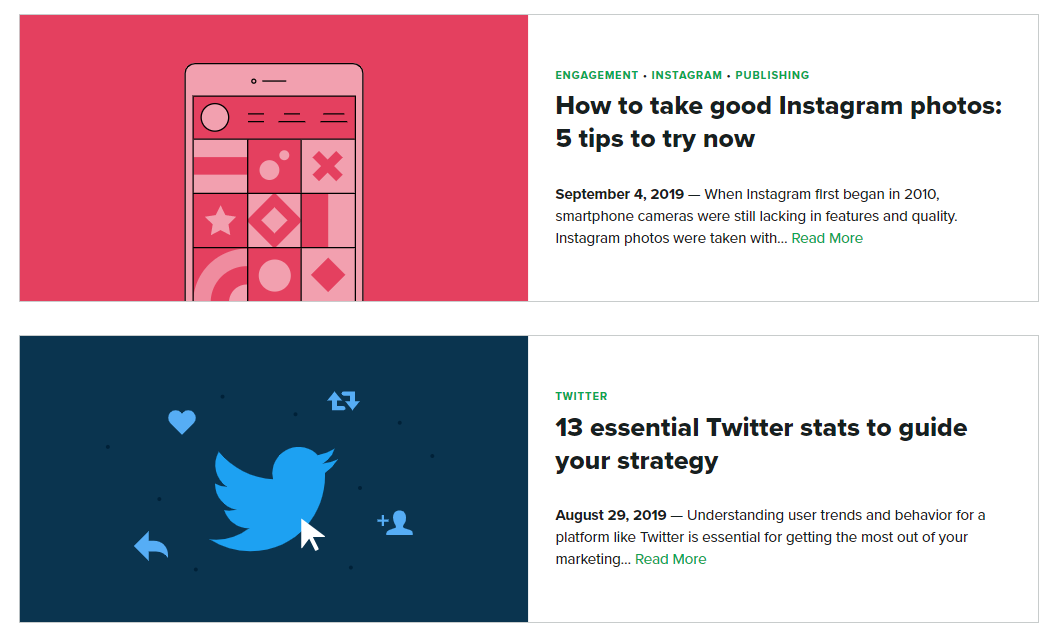
But solving a problem or answering a question is only half the battle.
After all, there are dozens (or hundreds) of blog posts out there covering any given topic.
So not only should your blog post solve a problem, but also do so in a meaningful way.
This might mean breaking down a complex topic with a more digestible approach or going in-depth on a topic that needs addressing in detail.
Considering that most high-performing blog posts around over 1,000 words according to Orbit Media, conventional wisdom tells us that top-tier posts go beyond basic information and dig into specifics.
Sprout's own 'Best Times to Post on Social Media' is a great example, brimming with original data and graphs. That's exactly why it's one of our top-performing posts.
They're easy to read
This might seem like a no-brainer, but readability is easy to overlook.
Spoiler alert: most readers have microscopic attention spans.
If your post puts 'em to sleep within the first few seconds, chances are they'll look elsewhere for information. This is especially true in a day and age where people can simply watch a video in lieu of reading a blog post.
As a writer, it's your job to find a balance between relaying in-depth information and keeping your audience's attention.
You can't expect folks to slog through a wall of text. Instead, you should make a point to avoid jargon and present your content in a style that doesn't make you sound like a robot.
For example, The Verge's 'How to Choose a Fitness Tracker' is a fairly straightforward example of a simple post that gets the job done. Written at a 9th-grade level and broken up by subheaders and images, the post is easy to scan and understand for just about anyone.
Meanwhile, this post from marketing expert Brittany Berger manages to deliver a valuable lesson in marketing with a simple sentence structure and conversational tone. Presented as playful with a distinct voice and plenty of visuals to break up the text, readers naturally move from line to line wondering what comes next.
Developing a writing style comes with practice. The beauty of blogging is that you aren't typically tied to strict formatting guidelines of traditional writing 'rules' that might make your content sound stuffy.
They're optimized (but not too optimized!)
Given the fierce competition among marketers and search engines alike, optimizing your content for SEO (and social!) is a must-do.
Optimization is yet another balancing act, though. From keyword stuffing to clickbait and beyond, writers can't afford to sacrifice readability and quality for the sake of trying to score clicks.
But as proven by tons of bloggers out there, it's possible to find that balance between writing for humans and search engines. For example, posts like 'How to Build Your Social Media Marketing Strategy' are able to hit on crucial keywords in a way that's natural and doesn't distract the reader at all.
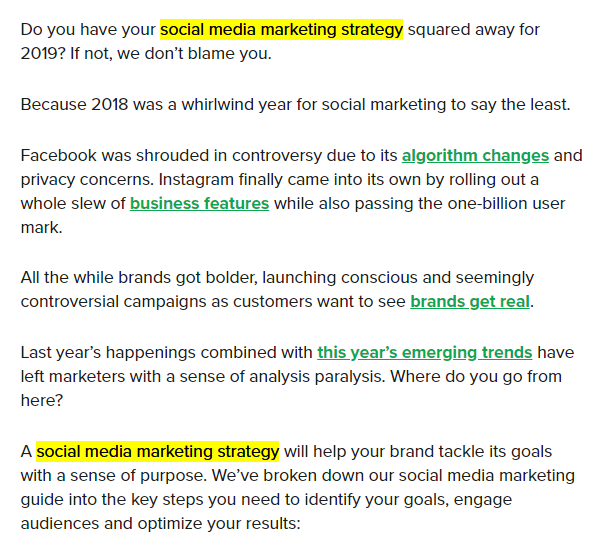
If you keep these three principles in mind each time you sit down to write a post, you're already way ahead of the curve.
How to write better blog posts: Our foolproof framework
Okay, so how do you take these tips and put them into action when it comes time to write?
Good question!
Staring at the proverbial blank page is one of the worst feelings in the world for blog writers.
That's why we recommend having some sort of framework in place when it comes time to write a blog post. This rings true whether you're starting a post from scratch or are revising older content. Below is our list of tactics and tools to help get you going.
Choose a blog post format before you start writing
Instead of relying on a cut-and-paste blog post template that might come off as cookie-cutter to readers, we recommend simply picking a blog post format before you start writing a post.
Doing so will make it much easier to organize your ideas and actually start writing.
Below are three types of blog posts that typically get shared around. Although these certainly aren't the only types of blog posts, they're can be adapted to just about any topic with ease.
How-to's, which live up to their namesake by explaining how to tackle a certain task or problem (ex: 'How to Get a Customer to Edit Their Negative Review')Listicles, which is simply a blog post formatted as a list (ex: 'The Business of DIY: 10 Things to Make and Sell Online')Question-based posts, which respond to or pose a question with Who, What, When, or Where? (ex: 'Why Netflix Cancelled Your Favorite Show' or ex: 'When is the Best Time to Send Emails?')Let's briefly break down each of these types of blog posts and why they work so well.
How-to blog posts
The concept of a how-to post is self-explanatory. Such posts provide an opportunity to take a deep dive into a specific topic. How-to posts have very specific search-intent and allow you to target niche audiences looking for expertise.
Given that many Google searches are centered around 'how to' queries, it's no surprise that many businesses use them as the foundation for their blogs. For example, brands like Campaign Monitor put together tons of how-to guides covering specific topics for their audience of email marketers.

Listicle blog posts
Popularized by the likes of Buzzfeed, list-style posts might seem a bit overdone or cliche.
However, it's hard to ignore their popularity and why they're all the rage in the first place.
After all, listicles are easy to digest at a glance and can be skimmed by busy readers. Additionally, subheaders can help people zero in on key points without necessarily having to read an entire article.

Additionally, lists are straightforward for writers to put together and can help break down larger topics into smaller pieces. For writers and readers alike, this sort of simplicity is a win-win.
Question-based blog posts
These types of posts address a specific question readers might have, helping writers hone in their focus on a single topic.
Unlike how-to posts, these types of blogs don't necessarily teach readers how to do something but rather provide insight to the topic at hand.
These types of posts can be broad in scope but do well to pique the curiosity of the reader. This headline and post from The Takeout is a great example of a question-based blog that's click-worthy at a glance. Even if you weren't curious about meatless meats before, chances are you are now.

Make sure your headline packs a punch
There's an oft-cited claim that 80% of people will decide whether or not to read something based on its headline.
Meanwhile, 60% of people will actually share an article on social media without actually reading it.
In a day and age dominated by clickbait headlines, bloggers are tasked with writing compelling headlines that attract readers without pulling a bait-and-switch.
How do you make it happen, though? Most of the examples we've cited so far represent click-worthy, shareable content that you'd see passed around social based on their headlines.
Perhaps what's most important is framing your article as presenting can't-miss.
For example, 'The Most Important Social Media Metrics to Track' doesn't just cover any social metrics: it covers the most important ones.
Or consider the 'must' in '9 Skills Every Social Media Manager Must Have.' By presenting these skills as must-have, readers naturally want to see if their own skills match up the post.
See how that works?
To figure out whether or not your headline packs a punch, tools such as CoSchedule's headline analyzer can be a game-changer. In short, the tool assigns a score to your headlines based on readability, 'power words' and other elements that drive people to read and share posts.
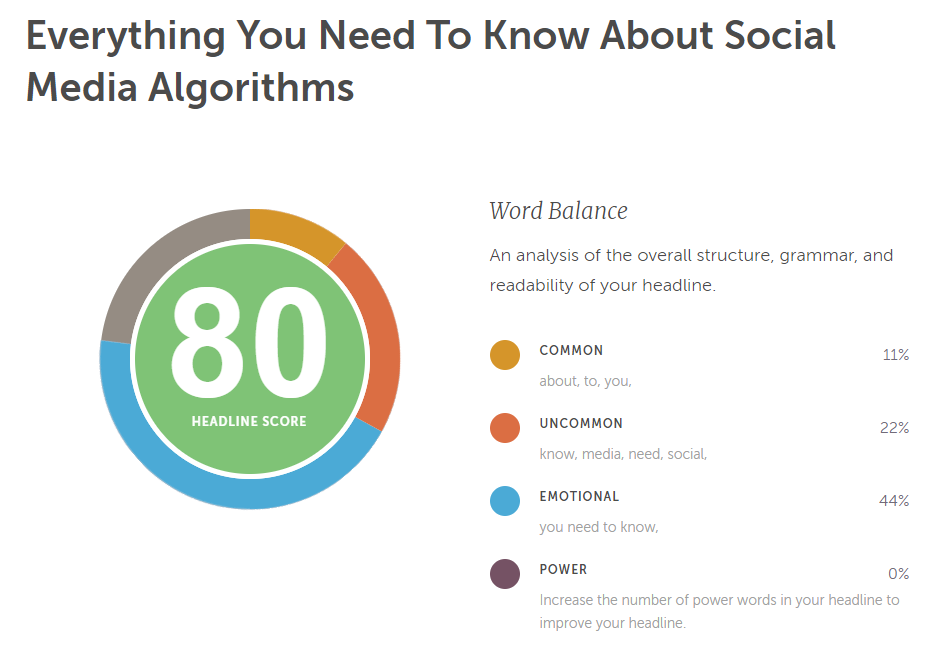
This tool isn't the be-all, end-all of headline writing but can definitely help you brainstorm ideas.
Double-check your content and formatting for readability
Conventional wisdom tells us that most people read at a 7th-grade level.
Translation? Businesses should strive to avoid language that's too lofty, if possible.
Remember: you're not writing a college essay. Rules such as 'five to seven sentences per paragraph' that you learned in English class don't exactly fly in the blogging world.
Tools such as the Hemingway Editor can help you identify opportunities to make your content more readable. The cut-and-paste app detects words and sentences that might be confusing to readers and highlights them throughout your text.
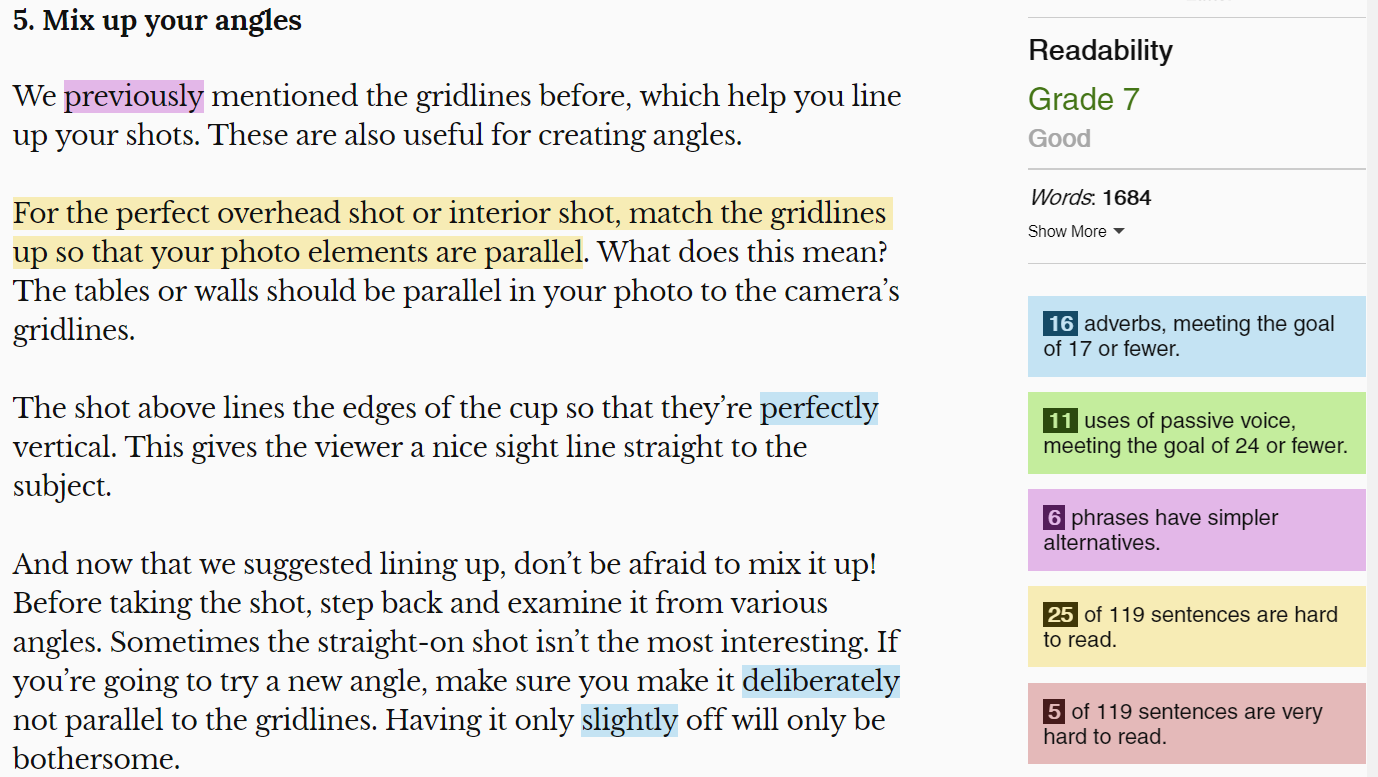
Many writers also use tools like Grammarly to avoid common grammatical issues and awkward phrases. This is an especially useful tool if you're new to blog writing or don't often write long-form content.
We should note that while readability checkers are definitely useful, you shouldn't expect anything you write to be totally 'perfect' based on these tools. The checks they run represent just one set of guidelines, and as you develop a unique writing voice you’ll inevitably vary a bit from them.
Your audience matters too: for example, let's say you're writing about a technical subject are addressing a college-educated audience. A higher readability grade is just fine in these cases.
But also consider that it's possible to cover technical topics without completely going over your readers' head. Case in point, Wired's 'AI and the Future of Work' touches on a topic for the tech-savvy but is written as an accessible 9th-grade level.
You've probably noticed by now that so much of figuring out how to write a blog post is a balancing act. The more you write, the easier it is to find those balances over time.
Format your post to be scroll-friendly
Formatting is a huge aspect of readability and shareability for your blog posts.
Think about how the format of your point can naturally draw your reader from one sentence to the next.
That's why most bloggers restrict their paragraphs to no more than three sentences. This helps create a sense of flow and likewise won't overwhelm anyone reading a post via mobile.
Posts should also be broken up frequently by subheaders, again making your content easy to scan. Many bloggers try to insert a subheader at least every 300 words.
Beyond subheaders, visuals are also a critical component of format and readability.
Considering that 65% of people consider themselves to be visual learners, don't neglect the importance of giving your readers something to look at beyond text.
Note that we typically include a variety of examples, images and screenshots throughout our posts here at Sprout. Most bloggers include three to four images per blog post, but writers should feel free to include as many visuals as they see fit.
What sort of visuals are we talking about, though?
Going beyond stock photos or screenshots, consider how you can whip up a graphic or quote with the help of a tool like Canva.
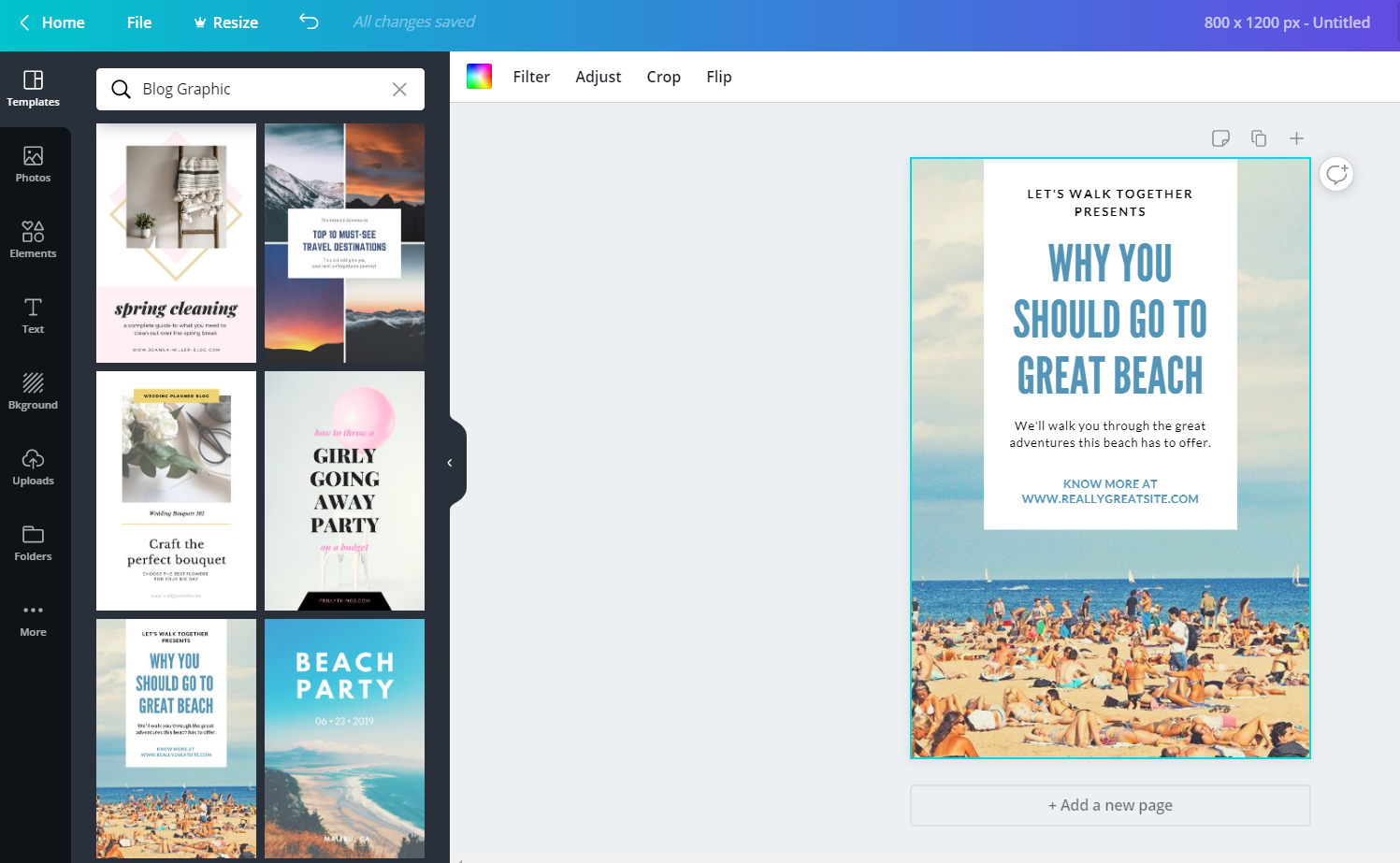
Bear in mind that you can also use social embeds to break up your blog posts, too. For bloggers using WordPress, social links you copy-and-paste will immediately populate without issue.
Agencies, forget quick wins. It's time to play to your existing strengths. #ThinkActAdapt #AgencyLife https://t.co/qsRiFzlcGt
— Sprout Social (@SproutSocial) September 10, 2019








